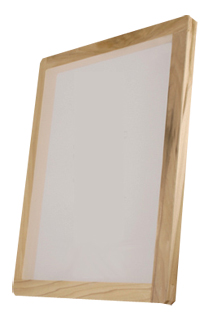Learn How To Screen Print With Catspit Productions, LLC
Screen Printing Mesh Preparation: Getting Mesh Ready For Emulsion
One way to ensure that you can make high quality stencils easily is to prepare the mesh for emulsion coating properly. Mesh preparation or "mesh prep" is a crucial phase in the screen making process that may often be over looked. Proper preparation of the mesh is an inexpensive way to improve stencil adhesion, prevent fisheyes, pinholes, and premature stencil breakdown.
When screen printing mesh manufacturers finish making the mesh it is cleaned. But the mesh has a long way to go from the factory to your print shop. It is during the transportation and subsequent handling at different points during transport that will contaminate the mesh. Even receiving, handling and screen stretching in your own print shop will leave greasy residues, dust, and dirt on the mesh. In order to create an ideal situation for the emulsion to adhere to the mesh and do its job properly, we must prepare the mesh correctly.
 There are 2 parts to proper mesh preparation. First the mesh must be thoroughly cleaned and degreased for reasons stated above. Second the mesh should be abraded. Abrasion of the mesh is not always recommended for direct liquid emulsions but is suggested for capillary films. But abrading the mesh will improve emulsion adhesion in either application and it is a good idea to abrade your mesh some only when it is brand new. Be careful not to over abrade the mesh and cause premature mesh wear.
There are 2 parts to proper mesh preparation. First the mesh must be thoroughly cleaned and degreased for reasons stated above. Second the mesh should be abraded. Abrasion of the mesh is not always recommended for direct liquid emulsions but is suggested for capillary films. But abrading the mesh will improve emulsion adhesion in either application and it is a good idea to abrade your mesh some only when it is brand new. Be careful not to over abrade the mesh and cause premature mesh wear.
Degreasing should be performed every time you coat a screen with emulsion. There are many degreasing and abrading combination chemicals which will do both steps at the same time. Other products are made to work individually. Ulano's Microgrit is a fine powder that is used independently of a degreaser. If you are a home based printer and choose to use a household scrubbing detergent like Comet� or SoftScrub� be aware that these cleaning agents have grit that is too coarse for this purpose. Using these products can damage the mesh which can increase staining and hazing problems with the mesh as well as weaken its integrity. Also note that if you use a dish detergent for degreasing, most brands contain lanolin or wool grease, which keeps skin from drying out. Those additives may make the degreasing counterproductive.
Degreasers can be purchased with or without wetting agents. A degreaser with a wetting agent will leave a smooth, even, sheet of water on the mesh when rinsed. This type of degreaser with wetting agent is recommended for use with capillary films although many stencil technicians in the industry claim that they also improve the coating ability for direct liquid emulsions. Degreasers without wetting agents are designed for use with direct liquid emulsions. Some popular degreasers without wetting agents include Ulano #3 Degreaser and Chemical Consultants, (ICC), Nutralyze. There are manufacturers who make wetting agents separate from the degreaser, such as Ulano #25 All Mesh Prep and Chromaline, Chroma/Wet Wetting Agent.
It is best to use a degreaser and a mesh abrader separately so that you can only abrade the mesh when you need to. Degreasing is recommended every time you coat your screens but abrading is not. For best results, purchase degreasers and mesh abraders that are specifically manufactured for screen printing applications. Make sure to follow the manufacturer's instructions for chemical usage and disposal.


 Screenprinting Equipment From Catspit Productions
Screenprinting Equipment From Catspit Productions


